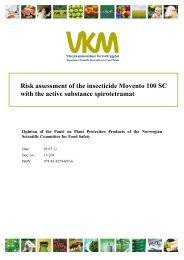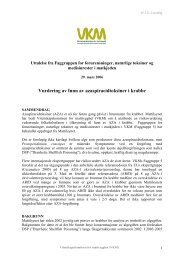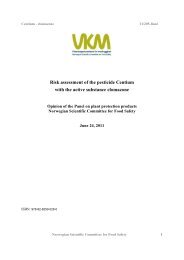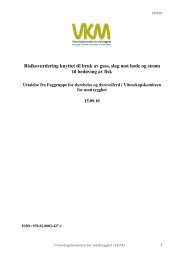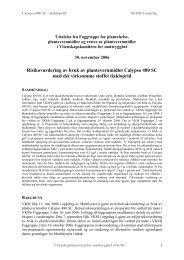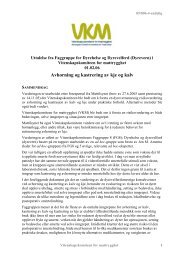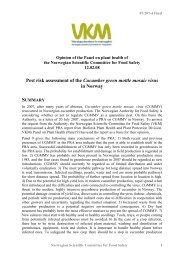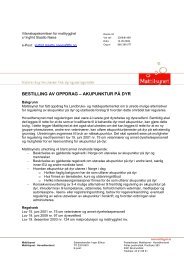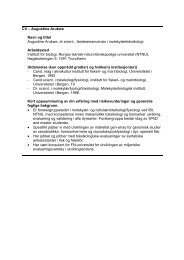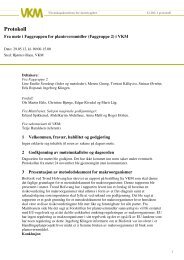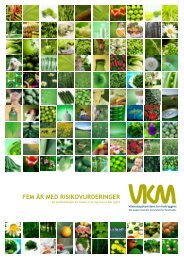Opinion of the Panel on Food Additives, Flavourings, Processing ...
Opinion of the Panel on Food Additives, Flavourings, Processing ...
Opinion of the Panel on Food Additives, Flavourings, Processing ...
Create successful ePaper yourself
Turn your PDF publications into a flip-book with our unique Google optimized e-Paper software.
04/407-13 final<br />
<str<strong>on</strong>g>Opini<strong>on</strong></str<strong>on</strong>g> <str<strong>on</strong>g>of</str<strong>on</strong>g> <str<strong>on</strong>g>the</str<strong>on</strong>g> <str<strong>on</strong>g>Panel</str<strong>on</strong>g> <strong>on</strong> <strong>Food</strong> <strong>Additives</strong>, <strong>Flavourings</strong>, <strong>Processing</strong> Aids, Materials in<br />
C<strong>on</strong>tact with <strong>Food</strong>, and Cosmetics <str<strong>on</strong>g>of</str<strong>on</strong>g> <str<strong>on</strong>g>the</str<strong>on</strong>g> Norwegian Scientific Committee for <strong>Food</strong><br />
Safety<br />
Adopted 1 July 2005<br />
Comments c<strong>on</strong>cerning Henna (Laws<strong>on</strong>ia inermis) for hair-dyeing<br />
SUMMARY<br />
The Norwegian <strong>Food</strong> Safety Authority (Mattilsynet) has asked <str<strong>on</strong>g>the</str<strong>on</strong>g> Norwegian Scientific<br />
Committee for <strong>Food</strong> Safety (Vitenskapskomiteen for mattrygghet, VKM) to c<strong>on</strong>sider <str<strong>on</strong>g>the</str<strong>on</strong>g><br />
health risk related to <str<strong>on</strong>g>the</str<strong>on</strong>g> use <str<strong>on</strong>g>of</str<strong>on</strong>g> Henna products for hair-dyeing. The case has been assessed by<br />
<str<strong>on</strong>g>the</str<strong>on</strong>g> <str<strong>on</strong>g>Panel</str<strong>on</strong>g> <strong>on</strong> <strong>Food</strong> <strong>Additives</strong>, <strong>Flavourings</strong>, <strong>Processing</strong> Aids, Materials in C<strong>on</strong>tact with <strong>Food</strong>,<br />
and Cosmetics.<br />
Henna (CAS no. 84988-66-9) represents a natural material derived from dried leaves <str<strong>on</strong>g>of</str<strong>on</strong>g> <str<strong>on</strong>g>the</str<strong>on</strong>g><br />
plant Laws<strong>on</strong>ia inermis. In Europe it is mainly used as a hair dye based <strong>on</strong> <str<strong>on</strong>g>the</str<strong>on</strong>g> staining<br />
properties <str<strong>on</strong>g>of</str<strong>on</strong>g> <str<strong>on</strong>g>the</str<strong>on</strong>g> main active ingredient Laws<strong>on</strong>e, 2-hydroxy-1,4-naphthoquin<strong>on</strong>e (CAS no.<br />
83-72-7). Laws<strong>on</strong>e is known to be a natural part <str<strong>on</strong>g>of</str<strong>on</strong>g> Henna. It has been reported that <str<strong>on</strong>g>the</str<strong>on</strong>g><br />
c<strong>on</strong>centrati<strong>on</strong> <str<strong>on</strong>g>of</str<strong>on</strong>g> Laws<strong>on</strong>e in Henna can vary from 0 up to 1.5 %.<br />
The Scientific Committee <strong>on</strong> Cosmetic Products and N<strong>on</strong>-<strong>Food</strong> Products intended for<br />
C<strong>on</strong>sumers (SCCNFP) has evaluated <str<strong>on</strong>g>the</str<strong>on</strong>g> safety <str<strong>on</strong>g>of</str<strong>on</strong>g> both Laws<strong>on</strong>e and Henna several times in<br />
recent years. In <str<strong>on</strong>g>the</str<strong>on</strong>g>ir last opini<strong>on</strong> c<strong>on</strong>cerning Laws<strong>on</strong>e adopted <strong>on</strong> 16 February 2004 it was<br />
c<strong>on</strong>cluded that Laws<strong>on</strong>e has genotoxic/mutagenic potential in vitro and in vivo and that<br />
<str<strong>on</strong>g>the</str<strong>on</strong>g>refore no safe level for Laws<strong>on</strong>e can be established. Based <strong>on</strong> this opini<strong>on</strong> <str<strong>on</strong>g>the</str<strong>on</strong>g> EU<br />
Commissi<strong>on</strong> has recently decided to ban <str<strong>on</strong>g>the</str<strong>on</strong>g> use <str<strong>on</strong>g>of</str<strong>on</strong>g> Laws<strong>on</strong>e as a cosmetic ingredient, while<br />
<str<strong>on</strong>g>the</str<strong>on</strong>g> use <str<strong>on</strong>g>of</str<strong>on</strong>g> Henna (Laws<strong>on</strong>ia inermis) has been temporary allowed until December 2005.<br />
This assessment from <str<strong>on</strong>g>the</str<strong>on</strong>g> Norwegian Scientific Committee for <strong>Food</strong> Safety is limited to a<br />
semi-quantitative estimate <str<strong>on</strong>g>of</str<strong>on</strong>g> a possible cancer risk <str<strong>on</strong>g>of</str<strong>on</strong>g> Laws<strong>on</strong>e in Henna products for hair<br />
dyeing. The possible carcinogenic risk <str<strong>on</strong>g>of</str<strong>on</strong>g> in vivo mutagens is in general c<strong>on</strong>sidered to be more<br />
critical than germ cell mutagenesis. Since no safe level <str<strong>on</strong>g>of</str<strong>on</strong>g> exposure for mutagens can be<br />
established, <str<strong>on</strong>g>the</str<strong>on</strong>g> linear relati<strong>on</strong>ship with similar numerical values recently dem<strong>on</strong>strated<br />
between <str<strong>on</strong>g>the</str<strong>on</strong>g> lowest effective dose (LED) after oral administrati<strong>on</strong> for in vivo genotoxicity and<br />
<str<strong>on</strong>g>the</str<strong>on</strong>g> carcinogen dose descriptor T25 may <str<strong>on</strong>g>of</str<strong>on</strong>g>fer a pragmatic approach for a semi-quantitative<br />
cancer risk assessment. Thus LED divided with an extrapolati<strong>on</strong> factor <str<strong>on</strong>g>of</str<strong>on</strong>g> 25 000 would<br />
corresp<strong>on</strong>d to a life-time cancer risk <str<strong>on</strong>g>of</str<strong>on</strong>g> 10 -5 . The systemic exposure dose (SED) <str<strong>on</strong>g>of</str<strong>on</strong>g> Laws<strong>on</strong>e<br />
based <strong>on</strong> a worst case use situati<strong>on</strong> <str<strong>on</strong>g>of</str<strong>on</strong>g> Henna products was calculated to be 0.4 µg/kg body<br />
weight/day.<br />
Norwegian Scientific Committee for <strong>Food</strong> Safety 1
04/407-13 final<br />
Since <str<strong>on</strong>g>the</str<strong>on</strong>g> ratio LED (110 mg/kg bw/day)/25 000 is equal to 4.4 µg/kg bw/day and thus greater<br />
than SED (0.4 µg/kg bw/day), it follows that <str<strong>on</strong>g>the</str<strong>on</strong>g> possible cancer risk associated with <str<strong>on</strong>g>the</str<strong>on</strong>g> use<br />
<str<strong>on</strong>g>of</str<strong>on</strong>g> Henna products for hair-dyeing c<strong>on</strong>taining Laws<strong>on</strong>e would be negligible. The margin <str<strong>on</strong>g>of</str<strong>on</strong>g><br />
exposure (MoE) would be approximately 275 000 (LED/SED = 110 000 µg/kg bw/day/ 0.4<br />
µg/kg bw/day).<br />
BACKGROUND<br />
Henna (CAS no. 84988-66-9) represents a natural material derived from dried leaves <str<strong>on</strong>g>of</str<strong>on</strong>g> <str<strong>on</strong>g>the</str<strong>on</strong>g><br />
plant Laws<strong>on</strong>ia inermis. It is mainly used as a hair dye in Europe, based <strong>on</strong> <str<strong>on</strong>g>the</str<strong>on</strong>g> staining<br />
properties <str<strong>on</strong>g>of</str<strong>on</strong>g> <str<strong>on</strong>g>the</str<strong>on</strong>g> main active ingredient Laws<strong>on</strong>e, 2-hydroxy-1,4-naphthoquin<strong>on</strong>e (CAS no.<br />
83-72-7). Laws<strong>on</strong>e is known to be a natural part <str<strong>on</strong>g>of</str<strong>on</strong>g> Henna. It has been reported that <str<strong>on</strong>g>the</str<strong>on</strong>g><br />
c<strong>on</strong>centrati<strong>on</strong> <str<strong>on</strong>g>of</str<strong>on</strong>g> Laws<strong>on</strong>e in Henna can vary from 0 up to 1.5 % (1).<br />
The use <str<strong>on</strong>g>of</str<strong>on</strong>g> both Henna (Laws<strong>on</strong>ia inermis) and Laws<strong>on</strong>e as cosmetic ingredients for hairdying<br />
has been discussed by <str<strong>on</strong>g>the</str<strong>on</strong>g> EU Commissi<strong>on</strong> in recent years. Hence, <str<strong>on</strong>g>the</str<strong>on</strong>g> Scientific<br />
Committee <strong>on</strong> Cosmetic Products and N<strong>on</strong>-<strong>Food</strong> Products intended for C<strong>on</strong>sumers (SCCNFP)<br />
and o<str<strong>on</strong>g>the</str<strong>on</strong>g>r scientific experts groups around Europe have assessed if <str<strong>on</strong>g>the</str<strong>on</strong>g> use <str<strong>on</strong>g>of</str<strong>on</strong>g> <str<strong>on</strong>g>the</str<strong>on</strong>g> two<br />
substances could be c<strong>on</strong>sidered as safe.<br />
SCCNFP has due to c<strong>on</strong>tinuous occurrence <str<strong>on</strong>g>of</str<strong>on</strong>g> new toxicological data evaluated <str<strong>on</strong>g>the</str<strong>on</strong>g> safety <str<strong>on</strong>g>of</str<strong>on</strong>g><br />
Laws<strong>on</strong>e and Henna several times between 2001 and 2004. The first opini<strong>on</strong> <strong>on</strong> Laws<strong>on</strong>e was<br />
adopted during <str<strong>on</strong>g>the</str<strong>on</strong>g> 16 th plenary meeting <str<strong>on</strong>g>of</str<strong>on</strong>g> 13 March 2001 (2), and two additi<strong>on</strong>al opini<strong>on</strong>s <strong>on</strong><br />
Laws<strong>on</strong>e and <strong>on</strong>e c<strong>on</strong>cerning Henna were adopted during <str<strong>on</strong>g>the</str<strong>on</strong>g> 19 th and 21 th plenary meetings<br />
<str<strong>on</strong>g>of</str<strong>on</strong>g> 27 February (3) and 17 September 2002 (4,5), respectively. Their last opini<strong>on</strong> c<strong>on</strong>cerning<br />
Laws<strong>on</strong>e was adopted 16 February 2004 (1).<br />
In <str<strong>on</strong>g>the</str<strong>on</strong>g> opini<strong>on</strong> c<strong>on</strong>cerning Henna (Laws<strong>on</strong>ia inermis) adopted by <str<strong>on</strong>g>the</str<strong>on</strong>g> SCCNFP during <str<strong>on</strong>g>the</str<strong>on</strong>g> 21 th<br />
plenary meeting <str<strong>on</strong>g>of</str<strong>on</strong>g> 17 September 2002 (5) it was c<strong>on</strong>cluded that:<br />
“The present submissi<strong>on</strong> I <strong>on</strong> Laws<strong>on</strong>ia inermis is inadequate. Before any fur<str<strong>on</strong>g>the</str<strong>on</strong>g>r<br />
c<strong>on</strong>siderati<strong>on</strong>, a full and adequate dossier would be required, including:<br />
* specificati<strong>on</strong>s <str<strong>on</strong>g>of</str<strong>on</strong>g> <str<strong>on</strong>g>the</str<strong>on</strong>g> substance tested and marketed, and<br />
* adequate in vivo genotoxicity data <strong>on</strong> natural henna c<strong>on</strong>taining <str<strong>on</strong>g>the</str<strong>on</strong>g> maximum amount <str<strong>on</strong>g>of</str<strong>on</strong>g> 2-<br />
Hydroxy-1,4-naphthoquin<strong>on</strong>e.”<br />
The last reevaluated opini<strong>on</strong> c<strong>on</strong>cerning Laws<strong>on</strong>e adopted by <str<strong>on</strong>g>the</str<strong>on</strong>g> SCCNFP 16 February 2004<br />
(1) c<strong>on</strong>cluded that:<br />
“The SCCNFP is aware that some <str<strong>on</strong>g>of</str<strong>on</strong>g> <str<strong>on</strong>g>the</str<strong>on</strong>g> genotoxicity/mutagenicity data is equivocal.<br />
However, <strong>on</strong> balance, <str<strong>on</strong>g>the</str<strong>on</strong>g> SCCNFP c<strong>on</strong>siders that Laws<strong>on</strong>e has genotoxicity/mutagenicity<br />
potential in vitro and in vivo and that <str<strong>on</strong>g>the</str<strong>on</strong>g>refore no safe threshold for Laws<strong>on</strong>e can be<br />
established.”<br />
The c<strong>on</strong>clusi<strong>on</strong>s in <str<strong>on</strong>g>the</str<strong>on</strong>g> opini<strong>on</strong>s <strong>on</strong> Laws<strong>on</strong>e adopted by SCCNFP have been c<strong>on</strong>sidered as<br />
c<strong>on</strong>troversial as <str<strong>on</strong>g>the</str<strong>on</strong>g> mutagenic risk is debatable. Scientific experts in France, Germany and<br />
Denmark (6,7,8) c<strong>on</strong>sider Laws<strong>on</strong>e not to have a mutagenic potential, and have during <str<strong>on</strong>g>the</str<strong>on</strong>g><br />
discussi<strong>on</strong>s related to <str<strong>on</strong>g>the</str<strong>on</strong>g> use <str<strong>on</strong>g>of</str<strong>on</strong>g> Laws<strong>on</strong>e as a n<strong>on</strong>-oxidising colouring agent for hair dyeing<br />
in <str<strong>on</strong>g>the</str<strong>on</strong>g> recent years forwarded <str<strong>on</strong>g>the</str<strong>on</strong>g>ir point <str<strong>on</strong>g>of</str<strong>on</strong>g> view to <str<strong>on</strong>g>the</str<strong>on</strong>g> EU Commissi<strong>on</strong>.<br />
Norwegian Scientific Committee for <strong>Food</strong> Safety 2
04/407-13 final<br />
The SCCNFP opini<strong>on</strong> <strong>on</strong> Henna has not yet been reevaluated in <str<strong>on</strong>g>the</str<strong>on</strong>g> light <str<strong>on</strong>g>of</str<strong>on</strong>g> <str<strong>on</strong>g>the</str<strong>on</strong>g>ir recent<br />
opini<strong>on</strong>s <strong>on</strong> Laws<strong>on</strong>e so <str<strong>on</strong>g>the</str<strong>on</strong>g> opin<strong>on</strong> adopted during <str<strong>on</strong>g>the</str<strong>on</strong>g> 21 th plenary meeting <str<strong>on</strong>g>of</str<strong>on</strong>g> 17 September<br />
2002 (5) is still valid.<br />
REGULATION<br />
Based <strong>on</strong> <str<strong>on</strong>g>the</str<strong>on</strong>g> c<strong>on</strong>clusi<strong>on</strong> from SCCNFP that Laws<strong>on</strong>e has genotoxic and mutagenic potential<br />
in vitro and in vivo and <str<strong>on</strong>g>the</str<strong>on</strong>g>refore no safe threshold for Laws<strong>on</strong>e can be established, <str<strong>on</strong>g>the</str<strong>on</strong>g><br />
Standing Committee <strong>on</strong> Cosmetic Products in <str<strong>on</strong>g>the</str<strong>on</strong>g> EU Commissi<strong>on</strong> has at <str<strong>on</strong>g>the</str<strong>on</strong>g>ir recent meeting<br />
<str<strong>on</strong>g>of</str<strong>on</strong>g> 14-15 February 2005 decided to ban <str<strong>on</strong>g>the</str<strong>on</strong>g> use <str<strong>on</strong>g>of</str<strong>on</strong>g> Laws<strong>on</strong>e as a cosmetic ingredient (9).<br />
Therefore, Laws<strong>on</strong>e (CAS no. 83-72-7) will be included in Annex II (List <str<strong>on</strong>g>of</str<strong>on</strong>g> substances<br />
which must not form part <str<strong>on</strong>g>of</str<strong>on</strong>g> <str<strong>on</strong>g>the</str<strong>on</strong>g> compositi<strong>on</strong> <str<strong>on</strong>g>of</str<strong>on</strong>g> cosmetic products) <str<strong>on</strong>g>of</str<strong>on</strong>g> <str<strong>on</strong>g>the</str<strong>on</strong>g> Cosmetics Directive<br />
76/768/EEC.<br />
With regard to Henna (Laws<strong>on</strong>ia inermis) (CAS no. 84988-66-9), it was decided by <str<strong>on</strong>g>the</str<strong>on</strong>g><br />
Standing Committee <strong>on</strong> Cosmetic Products that “<str<strong>on</strong>g>the</str<strong>on</strong>g> submitted request needs to be<br />
supplemented in order for <str<strong>on</strong>g>the</str<strong>on</strong>g> SCCNFP to formulate a final opini<strong>on</strong>. Until <str<strong>on</strong>g>the</str<strong>on</strong>g>n Henna<br />
(Laws<strong>on</strong>ia inermis) should be included in Annex III, Part 2”. This implies that <str<strong>on</strong>g>the</str<strong>on</strong>g> substance<br />
will be temporarily allowed until December 2005. Henna (Laws<strong>on</strong>ia inermis) is <strong>on</strong>ly allowed<br />
for hair-dyeing and not for dyeing <str<strong>on</strong>g>of</str<strong>on</strong>g> <str<strong>on</strong>g>the</str<strong>on</strong>g> skin (9).<br />
TERMS OF REFERENCE<br />
In a first request dated 23 March 2004 <str<strong>on</strong>g>the</str<strong>on</strong>g> Norwegian <strong>Food</strong> Safety Authority (Mattilsynet)<br />
asked <str<strong>on</strong>g>the</str<strong>on</strong>g> Norwegian Scientific Committee for <strong>Food</strong> Safety (Vitenskapskomiteen for<br />
mattrygghet, VKM) to c<strong>on</strong>sider <str<strong>on</strong>g>the</str<strong>on</strong>g> mutagenic risk <str<strong>on</strong>g>of</str<strong>on</strong>g> <str<strong>on</strong>g>the</str<strong>on</strong>g> two cosmetic ingredients Laws<strong>on</strong>e<br />
and Henna (Laws<strong>on</strong>ia inermis).<br />
The <str<strong>on</strong>g>Panel</str<strong>on</strong>g> <strong>on</strong> <strong>Food</strong> <strong>Additives</strong>, <strong>Flavourings</strong>, <strong>Processing</strong> Aids, Materials in C<strong>on</strong>tact with <strong>Food</strong>,<br />
and Cosmetics discussed <str<strong>on</strong>g>the</str<strong>on</strong>g> first request from <str<strong>on</strong>g>the</str<strong>on</strong>g> Norwegian <strong>Food</strong> Safety Authority in a<br />
meeting <strong>on</strong> 23 February 2005. It was <str<strong>on</strong>g>the</str<strong>on</strong>g>n decided to ask for a revised request from <str<strong>on</strong>g>the</str<strong>on</strong>g><br />
Norwegian <strong>Food</strong> Safety Authority due to <str<strong>on</strong>g>the</str<strong>on</strong>g> recent decisi<strong>on</strong> by <str<strong>on</strong>g>the</str<strong>on</strong>g> EU Commissi<strong>on</strong> to ban<br />
Laws<strong>on</strong>e as such as a cosmetic ingredient.<br />
The Norwegian Scientific Committee for <strong>Food</strong> Safety received a revised request <strong>on</strong> 26 April<br />
2005. In this new request VKM is asked to c<strong>on</strong>sider <str<strong>on</strong>g>the</str<strong>on</strong>g> health risk related to <str<strong>on</strong>g>the</str<strong>on</strong>g> use <str<strong>on</strong>g>of</str<strong>on</strong>g> Henna<br />
for hair-dyeing. The assessment should be limited to assess a possible cancer risk by assuming<br />
that all Henna products c<strong>on</strong>tain 1.5 % <str<strong>on</strong>g>of</str<strong>on</strong>g> Laws<strong>on</strong>e as described by SCCNFP in <str<strong>on</strong>g>the</str<strong>on</strong>g>ir opini<strong>on</strong><br />
adopted 17 september 2002 (4). Ano<str<strong>on</strong>g>the</str<strong>on</strong>g>r calculati<strong>on</strong> should be based <strong>on</strong> <str<strong>on</strong>g>the</str<strong>on</strong>g> highest<br />
c<strong>on</strong>centrati<strong>on</strong> <str<strong>on</strong>g>of</str<strong>on</strong>g> Laws<strong>on</strong>e in Henna products for hair-dyeing being 0.3%, as has been found in<br />
a recent Danish survey (Hans Jørgen Talberg, pers<strong>on</strong>al communicati<strong>on</strong>).<br />
Norwegian Scientific Committee for <strong>Food</strong> Safety 3
04/407-13 final<br />
ASSESSMENT<br />
The request has been assessed by <str<strong>on</strong>g>the</str<strong>on</strong>g> <str<strong>on</strong>g>Panel</str<strong>on</strong>g> <strong>on</strong> <strong>Food</strong> <strong>Additives</strong>, <strong>Flavourings</strong>, <strong>Processing</strong> Aids,<br />
Materials in C<strong>on</strong>tact with <strong>Food</strong>, and Cosmetics <str<strong>on</strong>g>of</str<strong>on</strong>g> <str<strong>on</strong>g>the</str<strong>on</strong>g> Norwegian Scientific Committee for<br />
<strong>Food</strong> Safety.<br />
As it is emphasised in <str<strong>on</strong>g>the</str<strong>on</strong>g> revised request from <str<strong>on</strong>g>the</str<strong>on</strong>g> Norwegian <strong>Food</strong> Safety Authority,<br />
Laws<strong>on</strong>e as such has been banned as a cosmetic ingredient. The comments from <str<strong>on</strong>g>the</str<strong>on</strong>g> <str<strong>on</strong>g>Panel</str<strong>on</strong>g><br />
will <str<strong>on</strong>g>the</str<strong>on</strong>g>refore be <strong>on</strong> Henna (Laws<strong>on</strong>ia inermis) where Laws<strong>on</strong>e is <str<strong>on</strong>g>the</str<strong>on</strong>g> principal colouring<br />
ingredient. The last opini<strong>on</strong> c<strong>on</strong>cerning Laws<strong>on</strong>e adopted by <str<strong>on</strong>g>the</str<strong>on</strong>g> SCCNFP <strong>on</strong> 16 February<br />
2004 (1), where Laws<strong>on</strong>e is c<strong>on</strong>sidered to have genotoxic/mutagenic potential in vitro and in<br />
vivo, is used as a basis for <str<strong>on</strong>g>the</str<strong>on</strong>g> <str<strong>on</strong>g>Panel</str<strong>on</strong>g>`s comments.<br />
Hazard characterisati<strong>on</strong><br />
Much <str<strong>on</strong>g>of</str<strong>on</strong>g> <str<strong>on</strong>g>the</str<strong>on</strong>g> discussi<strong>on</strong> c<strong>on</strong>cerning whe<str<strong>on</strong>g>the</str<strong>on</strong>g>r Laws<strong>on</strong>e should be c<strong>on</strong>sidered to have similar<br />
properties as mutagens classified as category 3 according to Council Directive 67/548/EEC<br />
(10), is based <strong>on</strong> whe<str<strong>on</strong>g>the</str<strong>on</strong>g>r two micr<strong>on</strong>ucleus studies in mice (72 h sampling time) from<br />
Österreichisches Forschungszentrum from 1989 and 1990 should be c<strong>on</strong>cluded as positive or<br />
not (11,12). The first study states: “There was a significant increase in <str<strong>on</strong>g>the</str<strong>on</strong>g> incidence <str<strong>on</strong>g>of</str<strong>on</strong>g><br />
micr<strong>on</strong>ucleated polychromatic erythrocytes (MPE) in <str<strong>on</strong>g>the</str<strong>on</strong>g> 72 hour test group (combined males<br />
and female data) but not at <str<strong>on</strong>g>the</str<strong>on</strong>g> o<str<strong>on</strong>g>the</str<strong>on</strong>g>r harvest times. The positive c<strong>on</strong>trol agent gave <str<strong>on</strong>g>the</str<strong>on</strong>g><br />
expected results. The substance was positive in <str<strong>on</strong>g>the</str<strong>on</strong>g> micr<strong>on</strong>ucleus assay.” In <str<strong>on</strong>g>the</str<strong>on</strong>g> sec<strong>on</strong>d study<br />
it is stated: “There were significant increases in <str<strong>on</strong>g>the</str<strong>on</strong>g> incidence <str<strong>on</strong>g>of</str<strong>on</strong>g> micr<strong>on</strong>ucleated<br />
polychromatic erythrocytes at 110 and 250 mg/kg bw (combined males and female data) but<br />
not at 25 mg/kg bw. The results show evidence <str<strong>on</strong>g>of</str<strong>on</strong>g> a positive dose resp<strong>on</strong>se relati<strong>on</strong>ship and<br />
were reported to be increased bey<strong>on</strong>d <str<strong>on</strong>g>the</str<strong>on</strong>g> range <str<strong>on</strong>g>of</str<strong>on</strong>g> <str<strong>on</strong>g>the</str<strong>on</strong>g> historical negative c<strong>on</strong>trol data. The<br />
positive c<strong>on</strong>trol agent gave <str<strong>on</strong>g>the</str<strong>on</strong>g> expected results. The study c<strong>on</strong>firmed <str<strong>on</strong>g>the</str<strong>on</strong>g> results <str<strong>on</strong>g>of</str<strong>on</strong>g> <str<strong>on</strong>g>the</str<strong>on</strong>g><br />
previous study.” The lowest effective dose (LED) after oral administrati<strong>on</strong> giving a positive<br />
resp<strong>on</strong>se in <str<strong>on</strong>g>the</str<strong>on</strong>g> in vivo micr<strong>on</strong>ucleus test was 110 mg/kg bw.<br />
The relevance <str<strong>on</strong>g>of</str<strong>on</strong>g> <str<strong>on</strong>g>the</str<strong>on</strong>g> positive effects at 72 hours is disputed (6,7,8). If, however, <str<strong>on</strong>g>the</str<strong>on</strong>g> results at<br />
72 hours are accepted as positive it implies that Laws<strong>on</strong>e has similar properties as mutagens<br />
classified as category 3.<br />
No quantitative or semi-quantitative hazard characterisati<strong>on</strong> methods are currently in use for<br />
regulatory purposes <str<strong>on</strong>g>of</str<strong>on</strong>g> mutagens. Mutagens dem<strong>on</strong>strated to be carcinogenic are in general<br />
regulated <strong>on</strong> <str<strong>on</strong>g>the</str<strong>on</strong>g> basis <str<strong>on</strong>g>of</str<strong>on</strong>g> <str<strong>on</strong>g>the</str<strong>on</strong>g>ir carcinogenicity since <str<strong>on</strong>g>the</str<strong>on</strong>g> carcinogenic effect is c<strong>on</strong>sidered to be<br />
more critical than germ cell mutagenesis. In <str<strong>on</strong>g>the</str<strong>on</strong>g> case <str<strong>on</strong>g>of</str<strong>on</strong>g> mutagens where no carcinogenicity<br />
studies are available, no safe level <str<strong>on</strong>g>of</str<strong>on</strong>g> exposure can be established. However, <str<strong>on</strong>g>the</str<strong>on</strong>g> recent<br />
publicati<strong>on</strong> <str<strong>on</strong>g>of</str<strong>on</strong>g> Sanner and Dybing (13) dem<strong>on</strong>strating a linear relati<strong>on</strong>ship between LED after<br />
oral administrati<strong>on</strong> for in vivo genotoxicity and <str<strong>on</strong>g>the</str<strong>on</strong>g> carcinogen dose descriptor T25, with<br />
similar numerical values within a factor 5-10, may <str<strong>on</strong>g>of</str<strong>on</strong>g>fer a pragmatic approach for a semiquantitative<br />
cancer risk assessment.<br />
Exposure characterisati<strong>on</strong><br />
The Notes <str<strong>on</strong>g>of</str<strong>on</strong>g> Guidance for <str<strong>on</strong>g>the</str<strong>on</strong>g> Testing <str<strong>on</strong>g>of</str<strong>on</strong>g> Cosmetic Ingredients and <str<strong>on</strong>g>the</str<strong>on</strong>g>ir Safety Evaluati<strong>on</strong><br />
(SCCNFP/0690/03 Final) (14) indicate a weekly use <str<strong>on</strong>g>of</str<strong>on</strong>g> 35 ml for a semi-permanent hair dye,<br />
with a retenti<strong>on</strong> factor <str<strong>on</strong>g>of</str<strong>on</strong>g> 0.1. The area <str<strong>on</strong>g>of</str<strong>on</strong>g> skin related to <str<strong>on</strong>g>the</str<strong>on</strong>g> use <str<strong>on</strong>g>of</str<strong>on</strong>g> hair dyes is 580 cm 2 .<br />
Norwegian Scientific Committee for <strong>Food</strong> Safety 4
04/407-13 final<br />
According to <str<strong>on</strong>g>the</str<strong>on</strong>g> terms <str<strong>on</strong>g>of</str<strong>on</strong>g> reference a worst case exposure scenario is calculated assuming<br />
that <str<strong>on</strong>g>the</str<strong>on</strong>g> c<strong>on</strong>centrati<strong>on</strong> <str<strong>on</strong>g>of</str<strong>on</strong>g> Laws<strong>on</strong>e in Henna products is 1.5%. The <str<strong>on</strong>g>Panel</str<strong>on</strong>g> has also estimated<br />
<str<strong>on</strong>g>the</str<strong>on</strong>g> exposure to Henna products for hair-dyeing based <strong>on</strong> <str<strong>on</strong>g>the</str<strong>on</strong>g> highest c<strong>on</strong>centrati<strong>on</strong> <str<strong>on</strong>g>of</str<strong>on</strong>g><br />
Laws<strong>on</strong>e (0.3%) detected in a recent survey carried out in Denmark (Hans Jørgen Talberg,<br />
pers<strong>on</strong>al communicati<strong>on</strong>).<br />
With reference to <str<strong>on</strong>g>the</str<strong>on</strong>g> Notes <str<strong>on</strong>g>of</str<strong>on</strong>g> Guidance from SCCNFP <str<strong>on</strong>g>the</str<strong>on</strong>g> systemic exposure dosage (SED)<br />
<str<strong>on</strong>g>of</str<strong>on</strong>g> Laws<strong>on</strong>e in a finished cosmetic product can be calculated according to two different<br />
models for dermal absorpti<strong>on</strong>, depending <strong>on</strong> whe<str<strong>on</strong>g>the</str<strong>on</strong>g>r <str<strong>on</strong>g>the</str<strong>on</strong>g> dermal absorpti<strong>on</strong> is reported in<br />
µg/cm 2 or as a percentage <str<strong>on</strong>g>of</str<strong>on</strong>g> <str<strong>on</strong>g>the</str<strong>on</strong>g> substance applied (14).<br />
In <str<strong>on</strong>g>the</str<strong>on</strong>g> SCCNFP <str<strong>on</strong>g>Opini<strong>on</strong></str<strong>on</strong>g> <str<strong>on</strong>g>of</str<strong>on</strong>g> 16.02.04 <str<strong>on</strong>g>the</str<strong>on</strong>g> absorbed amount <str<strong>on</strong>g>of</str<strong>on</strong>g> Laws<strong>on</strong>e was reported to be 2.6<br />
± 1.8 µg/cm 2 based <strong>on</strong> a study with human dermatomed skin and <str<strong>on</strong>g>the</str<strong>on</strong>g> Franz diffusi<strong>on</strong> cell<br />
method. In this experiment 2 % Laws<strong>on</strong>e in a hair dye formulati<strong>on</strong> was used (1).<br />
In a recent abstract from Kraeling et al. (15) <str<strong>on</strong>g>the</str<strong>on</strong>g> absorpti<strong>on</strong> <str<strong>on</strong>g>of</str<strong>on</strong>g> Laws<strong>on</strong>e was assessed in <str<strong>on</strong>g>the</str<strong>on</strong>g><br />
case <str<strong>on</strong>g>of</str<strong>on</strong>g> two hair colour pastes using n<strong>on</strong>-viable human skin mounted in flow-through<br />
diffusi<strong>on</strong> cells. For <str<strong>on</strong>g>the</str<strong>on</strong>g> Henna paste products 0.29 and 1.4%, respectively, <str<strong>on</strong>g>of</str<strong>on</strong>g> <str<strong>on</strong>g>the</str<strong>on</strong>g> applied doses<br />
were absorbed into <str<strong>on</strong>g>the</str<strong>on</strong>g> receptor fluid in 24 h after <str<strong>on</strong>g>the</str<strong>on</strong>g> hair colour paste had remained <strong>on</strong> <str<strong>on</strong>g>the</str<strong>on</strong>g><br />
skin for 1 h.<br />
Below, <str<strong>on</strong>g>the</str<strong>on</strong>g> systemic exposure dose has been calculated both <strong>on</strong> <str<strong>on</strong>g>the</str<strong>on</strong>g> basis <str<strong>on</strong>g>of</str<strong>on</strong>g> µg absorbed per<br />
cm 2 using 2.6 ± 1.8 µg/cm 2 (1) and <strong>on</strong> percent absorbed using <str<strong>on</strong>g>the</str<strong>on</strong>g> highest percentage (1.4%)<br />
reported by Kraeling et al. (15).<br />
Exposure based <strong>on</strong> µg absorbed per cm 2<br />
SED = DA a (µg/cm 2 ) x 10 -3 mg/µg x SSA (cm 2 ) x F (day -1 ) x R<br />
60 kg<br />
SED = (mg/kg bw/day) = Systemic Exposure Dosage<br />
DA a (µg/cm 2 ) = Dermal Absorpti<strong>on</strong> reported as amount/cm 2<br />
SSA (cm 2 ) =<br />
Skin Surface Area expected to be treated with <str<strong>on</strong>g>the</str<strong>on</strong>g> finished<br />
cosmetic product<br />
F (day -1 ) =<br />
Frequency <str<strong>on</strong>g>of</str<strong>on</strong>g> applicati<strong>on</strong> <str<strong>on</strong>g>of</str<strong>on</strong>g> <str<strong>on</strong>g>the</str<strong>on</strong>g> finished product<br />
60 kg = default human body weight (bw)<br />
The following values were used:<br />
Dermal Absorpti<strong>on</strong> (DA a ) = 2.6 µg/cm 2 (1)<br />
Skin Surface Area (SSA) = 580 cm 2<br />
Frequency <str<strong>on</strong>g>of</str<strong>on</strong>g> applicati<strong>on</strong> <str<strong>on</strong>g>of</str<strong>on</strong>g> <str<strong>on</strong>g>the</str<strong>on</strong>g> finished product (F) = [1/7] day -1<br />
Retenti<strong>on</strong> factor (R) = 0.1<br />
Systemic exposure dose (SED) = 2.6 µg/cm 2 x 10 -3 mg/µg x 580 cm 2 x 1 day -1 x 0.1<br />
60 kg x 7<br />
= 0.0004 mg/kg bw/day<br />
= 0.4 µg/kg bw/day<br />
Norwegian Scientific Committee for <strong>Food</strong> Safety 5
04/407-13 final<br />
Exposure based <strong>on</strong> percent absorbed<br />
SED = A (g/day) x 1000mg/g x C (%)/100 x DA p (%)/100 x R<br />
60 kg<br />
SED = (mg/kg bw/day) = Systemic Exposure Dosage<br />
A (g/day) =<br />
Amount <str<strong>on</strong>g>of</str<strong>on</strong>g> <str<strong>on</strong>g>the</str<strong>on</strong>g> cosmetic product applied daily<br />
C (%) =<br />
<str<strong>on</strong>g>the</str<strong>on</strong>g> C<strong>on</strong>centrati<strong>on</strong> <str<strong>on</strong>g>of</str<strong>on</strong>g> <str<strong>on</strong>g>the</str<strong>on</strong>g> ingredient under study in <str<strong>on</strong>g>the</str<strong>on</strong>g> finished<br />
cosmetic product <strong>on</strong> <str<strong>on</strong>g>the</str<strong>on</strong>g> applicati<strong>on</strong> site<br />
DA p (%) =<br />
Dermal Absorpti<strong>on</strong> expressed as a percentage<br />
60 kg = default human body weight (bw)<br />
The following values were used:<br />
Maximum absorpti<strong>on</strong> through <str<strong>on</strong>g>the</str<strong>on</strong>g> skin (DA p ) = 1.4% (15)<br />
Exposure to hair dye formulati<strong>on</strong> (A) = 35 g/week x [1/7]<br />
Retenti<strong>on</strong> factor (R) = 0.1<br />
C<strong>on</strong>centrati<strong>on</strong> <str<strong>on</strong>g>of</str<strong>on</strong>g> dye in <str<strong>on</strong>g>the</str<strong>on</strong>g> formulati<strong>on</strong> (C) = 1.5 %<br />
Systemic exposure dose (SED) = 35 (g/day) x 1000mg/g x 1.5 (%)/100 x 1.4 (%)/100 x 0.1<br />
60 kg x 7<br />
= 0.0018 mg/kg bw/day<br />
= 1.8 µg/kg bw/day<br />
A similar calculati<strong>on</strong> based <strong>on</strong> <str<strong>on</strong>g>the</str<strong>on</strong>g> highest c<strong>on</strong>centrati<strong>on</strong> <str<strong>on</strong>g>of</str<strong>on</strong>g> Laws<strong>on</strong>e (0.3%) detected in<br />
Henna products in <str<strong>on</strong>g>the</str<strong>on</strong>g> recent survey carried out in Denmark (Hans Jørgen Talberg, pers<strong>on</strong>al<br />
communicati<strong>on</strong>) will result in an estimated SED <str<strong>on</strong>g>of</str<strong>on</strong>g> 0.4 µg/kg bw/day.<br />
Based <strong>on</strong> <str<strong>on</strong>g>the</str<strong>on</strong>g> dermal absorpti<strong>on</strong> model reported in µg/cm 2 a SED <str<strong>on</strong>g>of</str<strong>on</strong>g> 0.4 µg/kg bw/day is<br />
calculated. If <str<strong>on</strong>g>the</str<strong>on</strong>g> model based <strong>on</strong> percentage absorbed is used, and assuming a c<strong>on</strong>centrati<strong>on</strong><br />
<str<strong>on</strong>g>of</str<strong>on</strong>g> Laws<strong>on</strong>e in Henna products <str<strong>on</strong>g>of</str<strong>on</strong>g> 1.5 %, a SED <str<strong>on</strong>g>of</str<strong>on</strong>g> 1.8 µg/kg bw/day is estimated. Generally<br />
<str<strong>on</strong>g>the</str<strong>on</strong>g> latter model would overestimate <str<strong>on</strong>g>the</str<strong>on</strong>g> dermal absorpti<strong>on</strong> since <str<strong>on</strong>g>the</str<strong>on</strong>g> absorpti<strong>on</strong> experiment<br />
(15) was performed with a product <strong>on</strong> <str<strong>on</strong>g>the</str<strong>on</strong>g> market likely to c<strong>on</strong>tain a lower c<strong>on</strong>centrati<strong>on</strong> <str<strong>on</strong>g>of</str<strong>on</strong>g><br />
Laws<strong>on</strong>e. Using a c<strong>on</strong>centrati<strong>on</strong> <str<strong>on</strong>g>of</str<strong>on</strong>g> 0.3 % which was <str<strong>on</strong>g>the</str<strong>on</strong>g> highest amount found in <str<strong>on</strong>g>the</str<strong>on</strong>g> Danish<br />
study, a SED <str<strong>on</strong>g>of</str<strong>on</strong>g> 0.4 µg/kg bw/day was calculated in this model. In <str<strong>on</strong>g>the</str<strong>on</strong>g> following risk<br />
characterisati<strong>on</strong> we will <str<strong>on</strong>g>the</str<strong>on</strong>g>refore use <str<strong>on</strong>g>the</str<strong>on</strong>g> exposure based <strong>on</strong> µg absorbed per cm 2 (= 0.4<br />
µg/kg bw/day) as used by SCCNFP in <str<strong>on</strong>g>the</str<strong>on</strong>g>ir last opini<strong>on</strong> (1).<br />
Risk characterisati<strong>on</strong><br />
The possible carcinogenic risk <str<strong>on</strong>g>of</str<strong>on</strong>g> in vivo mutagens is in general c<strong>on</strong>sidered to be more critical<br />
than germ cell mutagenesis. The linear relati<strong>on</strong>ship with similar numerical values between <str<strong>on</strong>g>the</str<strong>on</strong>g><br />
lowest effective dose (LED) showing in vivo genotoxicity after oral administrati<strong>on</strong> and <str<strong>on</strong>g>the</str<strong>on</strong>g><br />
carcinogen dose descriptor T25 dem<strong>on</strong>strated in a recent publicati<strong>on</strong> <str<strong>on</strong>g>of</str<strong>on</strong>g> Sanner and Dybing<br />
(12) may <str<strong>on</strong>g>of</str<strong>on</strong>g>fer a pragmatic approach for a semi-quantitative cancer risk assessment. Thus<br />
LED divided with an extrapolati<strong>on</strong> factor <str<strong>on</strong>g>of</str<strong>on</strong>g> 25 000 would corresp<strong>on</strong>d to a lifetime cancer risk<br />
<str<strong>on</strong>g>of</str<strong>on</strong>g> 10 -5 . The magnitude <str<strong>on</strong>g>of</str<strong>on</strong>g> <str<strong>on</strong>g>the</str<strong>on</strong>g> extrapolati<strong>on</strong> factor to be used may depend <strong>on</strong> a number <str<strong>on</strong>g>of</str<strong>on</strong>g><br />
Norwegian Scientific Committee for <strong>Food</strong> Safety 6
04/407-13 final<br />
factors. In <str<strong>on</strong>g>the</str<strong>on</strong>g> case <str<strong>on</strong>g>of</str<strong>on</strong>g> Laws<strong>on</strong>e <str<strong>on</strong>g>the</str<strong>on</strong>g>re are different views as to whe<str<strong>on</strong>g>the</str<strong>on</strong>g>r <str<strong>on</strong>g>the</str<strong>on</strong>g> substance fulfills<br />
<str<strong>on</strong>g>the</str<strong>on</strong>g> criteria for classificati<strong>on</strong> as a mutagen category 3. Since <str<strong>on</strong>g>the</str<strong>on</strong>g> ratio LED (110 mg/kg<br />
bw/day)/25 000 is equal to 4.4 µg/kg bw/day and thus greater than SED (0.4 µg/kg bw/day), it<br />
follows that <str<strong>on</strong>g>the</str<strong>on</strong>g> possible cancer risk associated with <str<strong>on</strong>g>the</str<strong>on</strong>g> use <str<strong>on</strong>g>of</str<strong>on</strong>g> Henna products for hair-dyeing<br />
c<strong>on</strong>taining Laws<strong>on</strong>e would be negligible. The margin <str<strong>on</strong>g>of</str<strong>on</strong>g> exposure (MoE) would be<br />
approximately 275 000 (LED/SED = 110 000 µg/kg bw/day/ 0.4 µg/kg bw/day).<br />
CONCLUSION<br />
The <str<strong>on</strong>g>Panel</str<strong>on</strong>g> <strong>on</strong> <strong>Food</strong> <strong>Additives</strong>, <strong>Flavourings</strong>, <strong>Processing</strong> Aids, Materials in C<strong>on</strong>tact with <strong>Food</strong>,<br />
and Cosmetics <str<strong>on</strong>g>of</str<strong>on</strong>g> <str<strong>on</strong>g>the</str<strong>on</strong>g> Norwegian Scientific Committee for <strong>Food</strong> Safety is <str<strong>on</strong>g>of</str<strong>on</strong>g> <str<strong>on</strong>g>the</str<strong>on</strong>g> opini<strong>on</strong> that if<br />
Laws<strong>on</strong>e is c<strong>on</strong>sidered as an in vivo mutagen and using an estimated systemic exposure dose<br />
based <strong>on</strong> a worst case use situati<strong>on</strong>, <str<strong>on</strong>g>the</str<strong>on</strong>g> possible cancer risk associated with <str<strong>on</strong>g>the</str<strong>on</strong>g> use <str<strong>on</strong>g>of</str<strong>on</strong>g> Henna<br />
products for hair-dyeing c<strong>on</strong>taining Laws<strong>on</strong>e would be negligible.<br />
ASSESSED BY:<br />
<str<strong>on</strong>g>Panel</str<strong>on</strong>g> <strong>on</strong> <strong>Food</strong> <strong>Additives</strong>, <strong>Flavourings</strong>, <strong>Processing</strong> Aids, Materials in C<strong>on</strong>tact with food and<br />
Cosmetics:<br />
Jan Alexander (chair), Trine Husøy, Kristine Naterstad, Jan Erik Paulsen,<br />
Tore Sanner, Inger-Lise Steffensen<br />
Scientific coordinator from <str<strong>on</strong>g>the</str<strong>on</strong>g> secretariat: Tor Øystein Fotland<br />
REFERENCES<br />
1. SCCNFP (2002). <str<strong>on</strong>g>Opini<strong>on</strong></str<strong>on</strong>g> <str<strong>on</strong>g>of</str<strong>on</strong>g> <str<strong>on</strong>g>the</str<strong>on</strong>g> Scientific Committee <strong>on</strong> Cosmetic Products and N<strong>on</strong>-<br />
<strong>Food</strong> Products Intended for C<strong>on</strong>sumers c<strong>on</strong>cerning Laws<strong>on</strong>e adopted by <str<strong>on</strong>g>the</str<strong>on</strong>g> SCCNFP<br />
<strong>on</strong> 16 February 2004 by means <str<strong>on</strong>g>of</str<strong>on</strong>g> <str<strong>on</strong>g>the</str<strong>on</strong>g> written procedure. SCCNFP/0798/04<br />
http://europa.eu.int/comm/health/ph_risk/committees/sccp/documents/out254_en.pdf<br />
2. SCCNFP (2002). <str<strong>on</strong>g>Opini<strong>on</strong></str<strong>on</strong>g> <str<strong>on</strong>g>of</str<strong>on</strong>g> <str<strong>on</strong>g>the</str<strong>on</strong>g> Scientific Committee <strong>on</strong> Cosmetic Products and N<strong>on</strong>-<br />
<strong>Food</strong> Products Intended for C<strong>on</strong>sumers c<strong>on</strong>cerning Laws<strong>on</strong>e adopted by <str<strong>on</strong>g>the</str<strong>on</strong>g> SCCNFP<br />
during <str<strong>on</strong>g>the</str<strong>on</strong>g> 16 th Plenary meeting <str<strong>on</strong>g>of</str<strong>on</strong>g> 13 March 2001. SCCNFP/0385/00, final<br />
http://europa.eu.int/comm/health/ph_risk/committees/sccp/documents/out139_en.pdf<br />
3. SCCNFP (2002). <str<strong>on</strong>g>Opini<strong>on</strong></str<strong>on</strong>g> <str<strong>on</strong>g>of</str<strong>on</strong>g> <str<strong>on</strong>g>the</str<strong>on</strong>g> Scientific Committee <strong>on</strong> Cosmetic Products and N<strong>on</strong>-<br />
<strong>Food</strong> Products Intended for C<strong>on</strong>sumers c<strong>on</strong>cerning Laws<strong>on</strong>e adopted by <str<strong>on</strong>g>the</str<strong>on</strong>g> SCCNFP<br />
during <str<strong>on</strong>g>the</str<strong>on</strong>g> 19 th Plenary meeting <str<strong>on</strong>g>of</str<strong>on</strong>g> 27 February 2002. SCCNFP/0561/02, final<br />
http://europa.eu.int/comm/health/ph_risk/committees/sccp/documents/out159_en.pdf<br />
4. SCCNFP (2002). <str<strong>on</strong>g>Opini<strong>on</strong></str<strong>on</strong>g> <str<strong>on</strong>g>of</str<strong>on</strong>g> <str<strong>on</strong>g>the</str<strong>on</strong>g> Scientific Committee <strong>on</strong> Cosmetic Products and N<strong>on</strong>-<br />
<strong>Food</strong> Products Intended for C<strong>on</strong>sumers c<strong>on</strong>cerning Laws<strong>on</strong>e adopted by <str<strong>on</strong>g>the</str<strong>on</strong>g> SCCNFP<br />
during <str<strong>on</strong>g>the</str<strong>on</strong>g> 21 st Plenary meeting <str<strong>on</strong>g>of</str<strong>on</strong>g> 17 September 2002. SCCNFP/0583/02, final<br />
http://europa.eu.int/comm/health/ph_risk/committees/sccp/documents/out177_en.pdf<br />
5. SCCNFP (2002). <str<strong>on</strong>g>Opini<strong>on</strong></str<strong>on</strong>g> <str<strong>on</strong>g>of</str<strong>on</strong>g> <str<strong>on</strong>g>the</str<strong>on</strong>g> Scientific Committee <strong>on</strong> Cosmetic Products and N<strong>on</strong>-<br />
<strong>Food</strong> Products Intended for C<strong>on</strong>sumers c<strong>on</strong>cerning Laws<strong>on</strong>ia Inermis, Henna adopted<br />
Norwegian Scientific Committee for <strong>Food</strong> Safety 7
04/407-13 final<br />
by <str<strong>on</strong>g>the</str<strong>on</strong>g> SCCNFP during <str<strong>on</strong>g>the</str<strong>on</strong>g> 21 st Plenary meeting <str<strong>on</strong>g>of</str<strong>on</strong>g> 17 September 2002.<br />
SCCNFP/0505/01, final<br />
http://europa.eu.int/comm/health/ph_risk/committees/sccp/documents/out178_en.pdf<br />
6. LAWSONE Colipa No. C 146 – Submissi<strong>on</strong> IV, 5 July 2002<br />
7. BgVV (2002). Genotoxicity <str<strong>on</strong>g>of</str<strong>on</strong>g> 2-Hydroxy-1,4-naphthoquin<strong>on</strong>e (Laws<strong>on</strong>, CAS 83-72-<br />
7). Bewertung des BgVV (Bundesinstitut für gesundlichen Verbraucherschutz und<br />
Veterinärmedizin) vom 21 Juni 2002<br />
8. Evaluati<strong>on</strong> <str<strong>on</strong>g>of</str<strong>on</strong>g> Laws<strong>on</strong> for genotoxic activity, Note from Danish scientific experts<br />
forwarded to <str<strong>on</strong>g>the</str<strong>on</strong>g> EU Commissi<strong>on</strong> by <str<strong>on</strong>g>the</str<strong>on</strong>g> Danish Envir<strong>on</strong>mental Protecti<strong>on</strong> Agency<br />
(Miljøstyrelsen) 18 March 2004<br />
9. EU Commissi<strong>on</strong> (2005). Draft Commissi<strong>on</strong> Directive../…/EC <str<strong>on</strong>g>of</str<strong>on</strong>g> amending Council<br />
Directive 76/768/EEC, c<strong>on</strong>cerning cosmetic products, for <str<strong>on</strong>g>the</str<strong>on</strong>g> purposes <str<strong>on</strong>g>of</str<strong>on</strong>g> adapting<br />
Annexes II and III <str<strong>on</strong>g>the</str<strong>on</strong>g>reto to technical progress (regarding Laws<strong>on</strong> and Laws<strong>on</strong>ia<br />
inermis)<br />
10. Council Directive <str<strong>on</strong>g>of</str<strong>on</strong>g> 27 June <strong>on</strong> <str<strong>on</strong>g>the</str<strong>on</strong>g> approximati<strong>on</strong> <str<strong>on</strong>g>of</str<strong>on</strong>g> laws, regulati<strong>on</strong>s and<br />
administrative provisi<strong>on</strong>s relating to <str<strong>on</strong>g>the</str<strong>on</strong>g> classificati<strong>on</strong>, packaging and labelling <str<strong>on</strong>g>of</str<strong>on</strong>g><br />
dangerous substances (67/548/EEC)<br />
http://europa.eu.int/comm/envir<strong>on</strong>ment/dansub/home_en.htm#g<br />
11. Ott, E. Micr<strong>on</strong>ucleus test with FC 200488. Osterreichisches Forschungszentrum,<br />
Austria. Study No: 845/89. August 1989<br />
12. Ott, E. Micr<strong>on</strong>ucleus test with FC 200488. Osterreichisches Forschungszentrum,<br />
Austria. Study No: 1880. December 1990<br />
13. Sanner T. and Dybing, E. Comparis<strong>on</strong> <str<strong>on</strong>g>of</str<strong>on</strong>g> carcinogenic and in vivo genotoxic potency<br />
estimates. Basic & Clincal Pharmacology & Toxicology 2005, 96, 131-139.<br />
14. SCCNFP (2003). The SCCNFP´S Notes <str<strong>on</strong>g>of</str<strong>on</strong>g> Guidance for <str<strong>on</strong>g>the</str<strong>on</strong>g> Testing <str<strong>on</strong>g>of</str<strong>on</strong>g> Cosmetic<br />
Ingredients and <str<strong>on</strong>g>the</str<strong>on</strong>g>ir Safety Evaluati<strong>on</strong>, 5 th revisi<strong>on</strong> adopted by <str<strong>on</strong>g>the</str<strong>on</strong>g> SCCNFP during<br />
<str<strong>on</strong>g>the</str<strong>on</strong>g> 25 th Plenary meeting <str<strong>on</strong>g>of</str<strong>on</strong>g> 20 October 2003. (SCCNFP/0690/03 Final)<br />
http://europa.eu.int/comm/health/ph_risk/committees/sccp/documents/out242_en.pdf<br />
15. Kraeling, M., Jung C. and Br<strong>on</strong>augh R. Absorpti<strong>on</strong> <str<strong>on</strong>g>of</str<strong>on</strong>g> Laws<strong>on</strong>e through human skin.<br />
Abstract/Poster, 44 th SOT Annual Meeting 2005.<br />
Norwegian Scientific Committee for <strong>Food</strong> Safety 8



